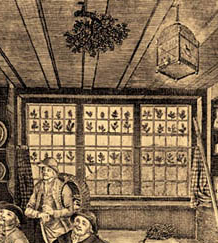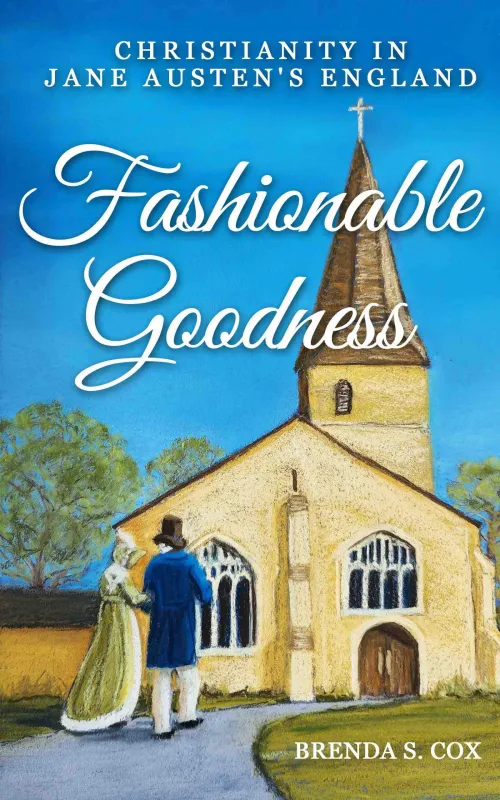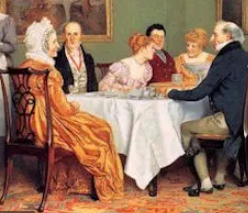
Sprigs of ivy in window panes and a bough of mistletoe overhead. Detail of a Bowles and Carver print, London. Circa 1775
On Christmas Eve the children laid out the traditional holly branches on the window ledges…” Jane Austen: A Life, Claire Tomalin, p. 4.
Christmas decorations during the Regency era were relatively simple compared to today’s standards, or even Victorian standards, when Christmas trees and wrapped packages made major appearances in common households.
[A Christmas Carol, by George Wither. From his “Juvenilia,” first printed in 1622.]
We all know of Jane Austen’s years in Bath, Somerset. Drury mentions that in this region no holly or mistletoe “was to be hung up before Christmas eve,” which gives us an idea of when the Austen’s purchased evergreens (for they were now city dwellers) to festoon their house. Drury’s passage for Somerset is somewhat confusing in the disposal of evergreens, for she jumps from Somerset to South Somerset to the customs of local churches, which all differ. She writes that “The importance of Christmas evergreen decorations in England is shown by the strict rules regarding their length of stay and the care taken in disposing of them when they were removed from the walls, a process which varies between and often within each county.”
In closing, Robert Herrick describes the best time of the year for the disposal of a variety evergreens throughout the calendar year in this poem…
CEREMONIES FOR CANDLEMAS EVE
Down with the rosemary and bays,
Down with the misletoe;
Instead of holly, now up-raise
The greener box, for show.
The holly hitherto did sway;
Let box now domineer,
Until the dancing Easter-day,
Or Easter’s eve appear.
Then youthful box, which now hath grace
Your houses to renew,
Grown old, surrender must his place
Unto the crisped yew.
When yew is out, then birch comes in,
And many flowers beside,
Both of a fresh and fragrant kin,
To honour Whitsuntide.
Green rushes then, and sweetest bents,
With cooler oaken boughs,
Come in for comely ornaments,
To re-adorn the house.
Thus times do shift; each thing his turn does hold;
New things succeed, as former things grow old.
Sources:
Tomalin, Claire, 1999. Jane Austen: A Life. New York, Random House, First Vintage Books Edition.
Customs and Beliefs Associated with Christmas Evergreens: A Preliminary Survey, Susan Dury. Folklore, Vol. 98, No.2 (1987), pp. 194-199. Published by Taylor & Francis, Ltd. on behalf of Folklore Enterprises, Ltd. Accessed 09-12-2018 at https://ww.jstor.org/stable/1259980
“Ceremony Upon Candlemas Eve,” Hesperides, or, The works both humane & divine of Robert Herrick, Esq. London: Printed for John Williams and Francis Eglesfield, 1648.
Christmas in Prints, Michael Olmert, 2008, Colonial Williamsburg
Other Christmas Posts on this Blog:
Click on this link for posts related to the topic
Another Interesting Blog Post About Christmas
But Surely Christmas in England Didn’t Exist Until Dickens Invented It? Austenonly








Such fun to read about such different and refreshing decorating ideas. I think I like it better than our current “If a little is good, a whole lot is a whole lot better” way of decorating. Thanks, Vic, and Merry Christmas!
Hi Vic. First I would like to wish you a very Happy Christmas.
The use of evergreens, holly, fir branches, ivy and of course mistletoe, if you can get hold of it, is being used again to a great extent in Britain. We are getting away from the manufactured glinting stuff.
The decorations in the Grant household this year are a real Chritsmas tree, some ivy and fir branches. We have a few twinkling little lights here and there.
All the best, Tony
Thanks for description of the usage of greens. I never thought about how and when they were disposed of. Merry Christmas!
Kevin, nowadays our local council recycles garden waste. They turn it into mulch and compost to put back into the ground to enrich the soil Recycling is a big thing here.Even waste that can’t be recycled is often incinerated in local power plants and turned into electricity. Plastic is a massive problem but there will be away if dealing with that in the future. Scientists are developing an enzyme which ,”eats,” plastic. The problem is how fast we can move on these issues and who wants to put barriers in the way………Know who I mean? Ha! Ha!
Tony, our city recycles those wonderful greens, too, to a local composting company. We also have a waste-to-energy facility, as well. And the high school kids pick up trees for a fund raiser so there are no worries getting rid of all the Christmas greens. I’m glad to hear England is doing all that, as well. I wish more US cities would get into the recycling mode. And yes…I got the “barrier” bit…:-)
Tony, here in Michigan we also recycle quite a bit now. There is a special collection after the holidays to pick up and recycle Christmas trees. We also have bulk collection of paper and plastic recycles, which I am very glad for. We have long been conservationists. And I do get your meaning. Merry Christmas to you and yours!!
Amazing there were so many rules, of course, it wasn’t a legally recognized bank holiday in England until 1834.
denise